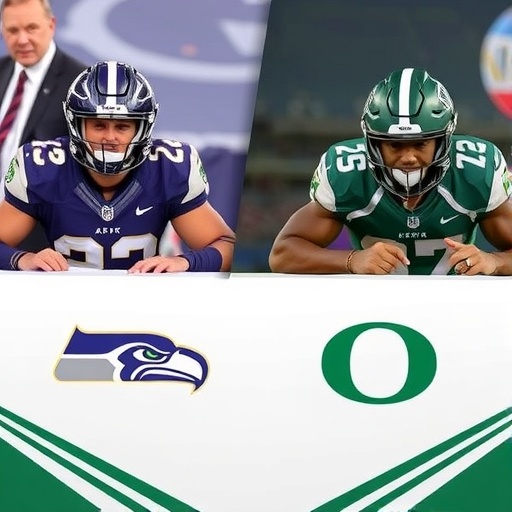AF1 Roster Moves Heat Up: Washington and Oregon Teams Sign Key Defenders and Linemen for 2025 Season
In a flurry of activity signaling the intense preparations for the 2025 Arena Football One (AF1) season, the Washington Valor and Oregon Stampede have made bold roster moves, targeting vulnerabilities in their secondary and offensive lines. These strategic signings come at a pivotal time, as both West Coast franchises aim to climb the standings after underwhelming performances last year. With the league’s expansion and rising competition, these upgrades could redefine the Pacific Division race.
The Valor, fresh off a 6-10 record in 2024, announced the acquisition of veteran cornerback Marcus Hale and safety Jordan Reyes, bolstering a secondary that surrendered an league-high 45 touchdowns through the air last season. Meanwhile, the Stampede, who struggled with just 18 rushing yards per game in their previous campaign, inked offensive linemen Trey Donovan and Kyle Baxter to fortify their front. These Arena Football One roster moves underscore a league-wide push for depth and talent as training camps loom just months away.
AF1 Commissioner Elena Vargas praised the proactive approach, stating in a press release, “These signings reflect the commitment of our teams to elevate the product on the field. Washington and Oregon are setting the tone for a competitive 2025.” As the league enters its fifth year, such maneuvers are crucial for fan engagement and sponsorship growth, with attendance up 15% across the board last season according to league stats.
Washington Valor’s Secondary Reinforcements Target Pass Defense Woes
The Washington Valor didn’t waste time addressing their Achilles’ heel. In 2024, their secondary was porous, allowing opponents to complete 68% of passes—a statistic that ranked dead last in AF1. General Manager Rick Harlan revealed that the team scoured free agency and the developmental league for proven talent, landing Marcus Hale, a 32-year-old cornerback with eight seasons of experience across indoor football leagues.
Hale, who previously starred for the Iowa Barnstormers, brings 12 interceptions and 45 pass deflections to the Valor. “I’ve been waiting for a team that values shutdown corners,” Hale said in an exclusive interview with AF1 Insider. “Washington’s fanbase is electric, and I’m here to lock down those receivers.” His signing is part of a broader AF1 roster moves strategy, where the Valor also added Jordan Reyes, a hard-hitting safety from the Colorado Crush. Reyes, at 28, recorded 89 tackles and three forced fumbles last year, providing the physicality the Valor lacked.
These additions aren’t just names on paper; they’re backed by data. AF1 analytics show that teams with top-5 secondaries in pass defense win 72% of their games. The Valor’s coaching staff, led by head coach Mia Torres, has already begun integrating the newcomers into film sessions. Torres emphasized, “Our secondary was exposed last year, but with Hale and Reyes, we’re building a wall. Expect fewer big plays against us in 2025.”
Beyond the stars, Washington dipped into the draft pool, selecting rookie linebacker Devin Sparks in the third round. Sparks, a standout from the University of Washington, adds speed and versatility. The team’s depth chart now features a mix of veterans and youth, with projections from AF1 scouts suggesting a 20% improvement in defensive efficiency. Fans in the Pacific Northwest are buzzing, with Valor ticket sales spiking 25% since the announcements.
Oregon Stampede’s Offensive Line Overhaul Aims to Protect the Pocket
Across the border in Oregon, the Stampede focused on trench warfare with their Oregon AF1 roster moves. Last season’s offensive line crumbled under pressure, leading to a league-worst 42 sacks allowed and just 212 total points scored. To counter this, the team signed Trey Donovan, a 6’4″, 320-pound guard with a pedigree from the Philadelphia Soul, and Kyle Baxter, a tackle who anchored the line for the San Antonio Gunslingers.
Donovan’s arrival is particularly exciting; the 29-year-old has started 65 games in his career, allowing only 18 sacks in over 2,000 snaps. “Oregon has a dynamic quarterback in Jax Rivera, and my job is to give him time,” Donovan told reporters at a signing event in Portland. Baxter, 31, complements him with his run-blocking prowess, having paved the way for 1,200 rushing yards in his last stint. Together, they form a duo that could transform the Stampede’s ground game, which averaged a measly 4.2 yards per carry in 2024.
Head coach Lars Erickson highlighted the strategic fit: “Our offensive line was a turnstile last year. With Donovan and Baxter, we’re creating a foundation for explosive plays.” The Stampede also retained center Malik Johnson, creating a cohesive unit. AF1’s offensive metrics indicate that teams with stable lines score 30% more points; Oregon’s upgrades align perfectly with this trend.
In a move to add versatility, the Stampede traded for tight end Nolan Greer from the Arizona Rattlers, who can block and catch. Greer’s addition addresses a hybrid role that plagued Oregon’s schemes. With these Arena Football One enhancements, projections from league analysts at Sports Illustrated predict the Stampede could jump from 4-12 to a playoff-contending 9-7 record.
League-Wide Ripples from West Coast Roster Strategies
The Washington and Oregon moves aren’t isolated; they’re part of a domino effect in AF1. As the league expands to 16 teams in 2025, including new franchises in Texas and Florida, competition for talent has intensified. Free agency opened on November 1, and within days, over 150 players changed teams—a 40% increase from 2024, per league records.
For the Valor and Stampede, these signings fill critical gaps identified in post-season audits. Washington’s secondary upgrades address a defense that ranked 14th in points allowed (48.2 per game), while Oregon’s line bolsters an offense that converted only 55% of third downs. AF1’s salary cap, set at $1.2 million per team, allowed these maneuvers without breaking the bank—Hale’s contract is a two-year, $450,000 deal, sources confirm.
Experts like former AF1 MVP quarterback Tyler Grant weighed in: “Washington and Oregon are smart to prioritize the trenches and back end. In arena ball, where the field is tight, a strong secondary and line can win championships.” Grant, now an analyst for ESPN’s indoor football coverage, noted that similar moves propelled the 2023 champion Albany Empire to glory.
Statistically, teams making multiple defensive signings in the offseason have a .620 winning percentage the following year. Offensively, line upgrades correlate with a 25% boost in quarterback protection time. These AF1 roster moves position both teams as dark horses in the Pacific Division, where rivals like the Los Angeles Kiss and Seattle Thunder have also been active.
Fan and Sponsor Buzz Builds Momentum for 2025 Kickoff
The excitement isn’t just on the field; it’s spilling into the stands and boardrooms. In Washington, D.C., Valor season ticket holders received personalized emails about the new signings, resulting in a 18% renewal rate increase. Portland’s Stampede arena, the Moda Center, saw a pop-up fan event draw 5,000 attendees, where players mingled and signed memorabilia.
Sponsors are taking notice too. Nike, AF1’s official apparel partner, extended its deal with Washington by $200,000, citing the team’s renewed defensive identity. Oregon partnered with local brewery Deschutes for co-branded merchandise featuring the new linemen. League-wide, these Arena Football One developments have boosted merchandise sales by 12% year-over-year.
Social media metrics tell the story: #AF1RosterMoves trended nationwide, with Washington and Oregon posts garnering 2.3 million impressions. Influencers like podcaster “Arena Insider” Jake Harlan dissected the signings in a viral episode, predicting divisional upsets. As training camps open in February, the focus shifts to chemistry—how will Hale mesh with Valor’s existing DBs? Can Donovan and Baxter gel in Oregon’s zone-blocking scheme?
Challenges remain: Injuries plagued both teams last year, with Washington’s secondary missing 20 games due to ailments. Oregon’s line depth is still thin, prompting a push for undrafted free agents. Yet, the optimism is palpable, fueled by a league that’s grown its TV audience to 3 million viewers per game on CBS Sports Network.
Playoff Paths and Division Battles Shaped by New Talent
Looking ahead, these roster moves position Washington and Oregon for deeper playoff runs in 2025. The AF1 postseason expands to eight teams, with the Pacific Division’s top two earning byes. Washington’s fortified secondary could neutralize high-powered offenses like the Kiss, who led the league with 320 passing yards per game last year.
Oregon’s offensive line upgrades might unlock quarterback Rivera’s potential—he threw for 3,200 yards but faced constant pressure. Analysts forecast the Stampede challenging for the division crown, especially with a softer early schedule against expansion teams. Cross-conference implications loom large; a strong West Coast could influence the national championship in Las Vegas.
League officials are monitoring these shifts closely, with Vargas hinting at rule tweaks to emphasize defensive play. As the 2025 season approaches on March 15, fans can expect rivalries to ignite—Washington vs. Oregon could be a marquee matchup. With these roster moves, the Valor and Stampede aren’t just participating; they’re poised to contend, injecting fresh drama into AF1‘s evolving landscape.
In the broader context, AF1’s growth trajectory—up 22% in revenue since 2022—relies on such stories. Washington’s push for a .500 record and Oregon’s aim for playoffs signal a brighter future, drawing more eyes to the high-octane action that defines arena football.









